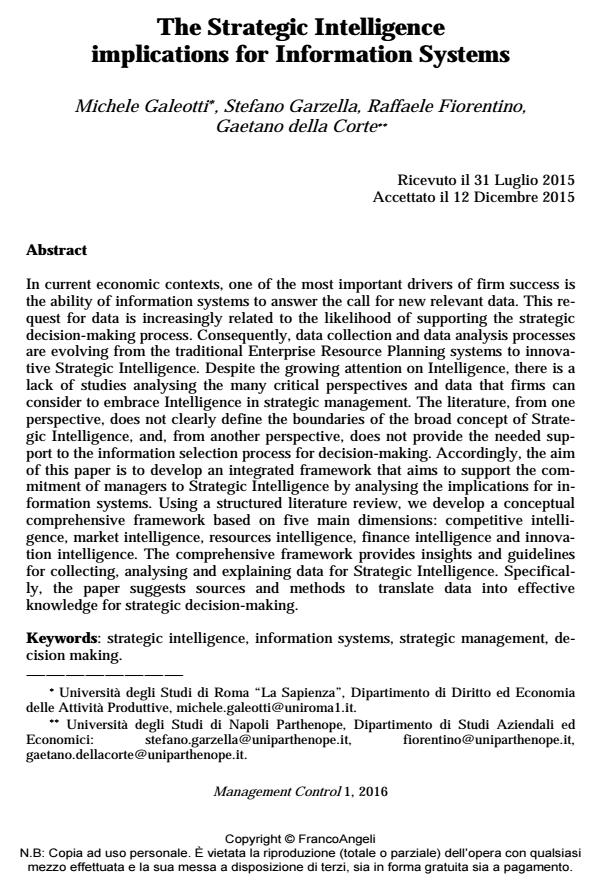The Strategic Intelligence implications for Information Systems
Journal title MANAGEMENT CONTROL
Author/s Michele Galeotti, Stefano Garzella, Raffaele Fiorentino, Gaetano della Corte
Publishing Year 2016 Issue 2016/1
Language Italian Pages 19 P. 105-123 File size 156 KB
DOI 10.3280/MACO2016-001007
DOI is like a bar code for intellectual property: to have more infomation
click here
Below, you can see the article first page
If you want to buy this article in PDF format, you can do it, following the instructions to buy download credits

FrancoAngeli is member of Publishers International Linking Association, Inc (PILA), a not-for-profit association which run the CrossRef service enabling links to and from online scholarly content.
In current economic contexts, one of the most important drivers of firm success is the ability of information systems to answer the call for new relevant data. This request for data is increasingly related to the likelihood of supporting the strategic decision-making process. Consequently, data collection and data analysis processes are evolving from the traditional Enterprise Resource Planning systems to innovative Strategic Intelligence. Despite the growing attention on Intelligence, there is a lack of studies analysing the many critical perspectives and data that firms can consider to embrace Intelligence in strategic management. The literature, from one perspective, does not clearly define the boundaries of the broad concept of Strategic Intelligence, and, from another perspective, does not provide the needed support to the information selection process for decision-making. Accordingly, the aim of this paper is to develop an integrated framework that aims to support the commitment of managers to Strategic Intelligence by analysing the implications for information systems. Using a structured literature review, we develop a conceptual comprehensive framework based on five main dimensions: competitive intelligence, market intelligence, resources intelligence, finance intelligence and innovation intelligence. The comprehensive framework provides insights and guidelines for collecting, analysing and explaining data for Strategic Intelligence. Specifically, the paper suggests sources and methods to translate data into effective knowledge for strategic decision-making.
Keywords: Strategic intelligence, information systems, strategic management, decision making.
- Strategic performance management systems in Italian banks. A research note Francesca Francioli, in MANAGEMENT CONTROL 2/2018 pp.155
DOI: 10.3280/MACO2018-002008 - La Business Intelligence e la Business Analytics nell'era dei Big Data: una analisi della letteratura Arianna Petrosino, Daniela Mancini, Stefano Garzella, Rita Lamboglia, in MANAGEMENT CONTROL 3/2018 pp.31
DOI: 10.3280/MACO2018-003003 - Management control systems package e turnaround: un caso aziendale Cristiana Cattaneo, Sara Sonzogni, in MANAGEMENT CONTROL 1/2021 pp.151
DOI: 10.3280/MACO2021-001008 - La Network Governance a supporto dell'Open Innovation: un'analisi della letteratura Palmira Piedepalumbo, Concetta Metallo, Daniela Mancini, in MANAGEMENT CONTROL 3/2017 pp.79
DOI: 10.3280/MACO2017-003006 - Applying business analytics for performance measurement and management. The case study of a software company Franco Visani, in MANAGEMENT CONTROL 2/2017 pp.89
DOI: 10.3280/MACO2017-002006 - Impatto della crisi economica su redditività e rischio finanziario delle imprese romagnole. Una cluster analysis Stefania Vignini, Tiziana De Cristofaro, in MANAGEMENT CONTROL 3/2018 pp.157
DOI: 10.3280/MACO2018-003008
Michele Galeotti, Stefano Garzella, Raffaele Fiorentino, Gaetano della Corte, The Strategic Intelligence implications for Information Systems in "MANAGEMENT CONTROL" 1/2016, pp 105-123, DOI: 10.3280/MACO2016-001007